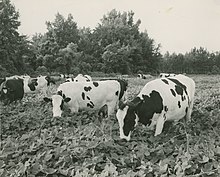Kudzu
The vine densely climbs over other plants and trees and grows so rapidly that it smothers and kills them by blocking most of the sunlight and taking root space.
[citation needed] Kudzu has been referred to as "quasi-wild" due to its long history of cultivation, selective breeding into various cultivars, and subsequent return to wild conditions.
The hard-coated seeds can remain viable for several years, and can successfully germinate only when soil is persistently soggy for 5–7 days, with temperatures above 20 °C (68 °F).
Kudzu is able to withstand environments ranging from sunny to shady upon reaching its mature stage; however, forest edges with greater light availability are optimal.
Kudzu competes with native flora for light, and acts to block their access to this vital resource by growing over them and shading them with its leaves.
[18]When kudzu invades an ecosystem, it makes the leaf litter more labile, thereby lessening the carbon sequestration ability of the soil.
[20] A small patch of kudzu was discovered in 2009 in Leamington, Ontario, the second-warmest growing region of Canada after south coastal British Columbia.
The new Soil Conservation Service grew seventy million kudzu seedlings and paid $8 an acre (equivalent to $174 in 2023) to anyone who would sow the vine.
Farmer and journalist Channing Cope, dubbed "kudzu kid" in a 1949 Time profile, popularised it in the South as a fix for eroded soils.
[20]Kudzu's ongoing mythos as a mile-a-minute invader is likely due to its visibility coating trees at wooded roadsides, thriving in the sunshine at the forest edge.
[28] This means that this species cannot be imported, cultivated, transported, commercialized, planted, or intentionally released into the environment anywhere in the European Union.
However, outbreaks in peripheral areas such as the Onsernone Valley and Lower Leventina are likely due to the illegal disposal of plant waste.
[31] During World War II, kudzu was introduced to Vanuatu and Fiji by United States Armed Forces to serve as camouflage for equipment and has become a major weed.
[36] These crowns and attached tuberous roots can weigh 400 or 500 pounds (180 to 225 kilograms) and extend up to twenty feet (six meters) into the ground.
[citation needed] Close mowing every week, regular heavy grazing for many successive years, or repeated cultivation may be effective, as this serves to deplete root reserves.
[citation needed] In the United States, the city of Chattanooga, Tennessee, undertook a trial program in 2010 using goats and llamas to graze on the plant.
Similar efforts to reduce widespread nuisance kudzu growth have also been undertaken in the cities of Winston-Salem, North Carolina,[38] and Tallahassee, Florida.
[43] Herbicides can be used after other methods of control, such as mowing, grazing, or burning, which can allow for an easier application of the chemical to the weakened plants.
[45] Since 1998, the United States' Agricultural Research Service has experimented with using the fungus Myrothecium verrucaria as a biologically based herbicide against kudzu.
[23] A diacetylverrucarol spray based on M. verrucaria works under a variety of conditions (including the absence of dew), causes minimal injury to many of the other woody plants in kudzu-infested habitats, and takes effect quickly enough that kudzu treated with it in the morning starts showing evidence of damage by midafternoon.
[23] Initial formulations of the herbicide produced toxic levels of other trichothecenes as byproducts, though the ARS discovered that growing M. verrucaria in a fermenter on a liquid diet (instead of a solid) limited or eliminated the problem.
The long runners which propagate the kudzu fields and the larger vines which cover trees make excellent weaving material.
[50][51][note 2] Compounds of icariin, astragalus, and puerarin mitigates iron overload in the cerebral cortex of mice with Alzheimer's disease.
In Korea, the plant root is made into chikcha (칡차; "arrowroot tea"), used in traditional medicine, and processed starch used for culinary purposes such as primary ingredient for naengmyeon (칡냉면).
[54] Nearby bee colonies may forage on kudzu nectar during droughts as a last resort, producing a low-viscosity red or purple honey that tastes of grape jelly or bubblegum.
'Kudzu Root Soup') is a herbal drink with its origin in traditional Chinese medicine, intended for people having various mild illnesses, such as headache.









